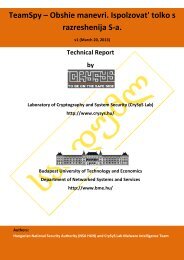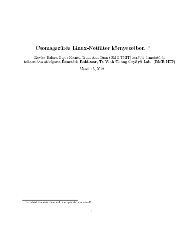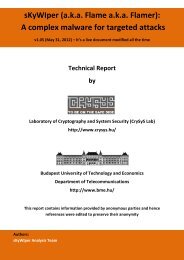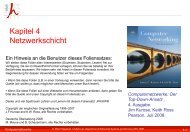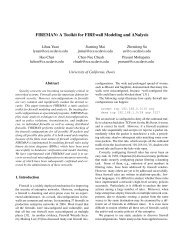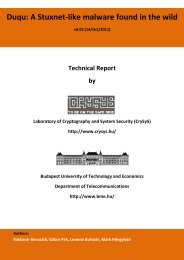Create successful ePaper yourself
Turn your PDF publications into a flip-book with our unique Google optimized e-Paper software.
3.2. Model of local attacker and mix zone<br />
k is an index of a vector. Every port-timeslot pair can be mapped to such an index and<br />
k can be mapped back to a port-timeslot pair. Therefore indices and port-timeslot pairs<br />
are interchangeable, and in the following discussion, I always use the one which makes the<br />
presentation simpler.<br />
k ∈ 1 . . . M · T , where M is the number of ports, and T is the length of the attack measured<br />
in timeslots.<br />
C = [ck] is a vector, where ck is the number of cars leaving the mix zone at k during the<br />
attack.<br />
N is the number of cars leaving the mix zone before timeslot T (i.e., N = ∑ MT<br />
k=1 ck).<br />
ps(k) is the probability of the event that the target vehicle leaves the mix zone at k (port<br />
and time) conditioned on the event that it enters the zone at port s at time 0. The attacker<br />
exactly knows which port is s. Probability ps(k) can be computed as: ps(k) = qsjfsj(t),<br />
where port j and timeslot t correspond to index k.<br />
p(k) is the probability of the event that a vehicle leaves the mix zone at k (port and time).<br />
This distribution can be calculated from the input distribution and the transition probabilities:<br />
p(k) = ∑ M<br />
s=1 ps(k).<br />
Pr(k|C) is the conditional probability that the target vehicle left the mix zone at time and<br />
port defined by k, given that the attacker’s observation is vector C.<br />
We must determine for which k probability Pr(k|C) is maximal. Let us denote this k with k ∗ .<br />
The probability Pr(k|C) can be rewritten, using the Bayes rule:<br />
Then k ∗ can be computed as:<br />
k ∗ = arg max<br />
k<br />
Pr(k|C) = Pr(C|k)ps(k)<br />
Pr(C)<br />
Pr(C|k)ps(k)<br />
Pr(C)<br />
= arg max Pr(C|k)ps(k)<br />
k<br />
Pr(C|k) has a multinomial distribution with a condition that at least one vehicle (the target of<br />
the attacker) must leave the mix zone at k:<br />
Pr(C|k) =<br />
N!<br />
c1! . . . ck−1!(ck − 1)!ck+1! . . . cMT ! p(k)ck−1<br />
MT ∏<br />
j=1,j̸=k<br />
Pr(C|k) can be multiplied and divided by p(k)<br />
to simplify the equation:<br />
ck<br />
Pr(C|k) = ck<br />
⎛<br />
MT<br />
⎝<br />
N! ∏<br />
p(j)<br />
p(k) c1! . . . cMT !<br />
cj<br />
⎞<br />
⎠<br />
j=1<br />
p(j) cj<br />
where the bracketed part is a constant, which does not have any effect on the maximization, thus<br />
it can be omitted.<br />
k ∗ = arg max<br />
k<br />
ck<br />
p(k) ps(k) = arg max<br />
k<br />
ck<br />
p(k)N ps(k) = arg max<br />
k<br />
pk<br />
p(k) ps(k)<br />
where pk is the empirical distribution of k (i.e., pk = ck/N). If the number of vehicles in the<br />
mix zone is large enough, then pk<br />
p(k) ≈ 1. Thus correctness of the intuitive algorithm described in<br />
Subsection 3.2.3 holds:<br />
k ∗ = arg max ps(k)<br />
k<br />
33



